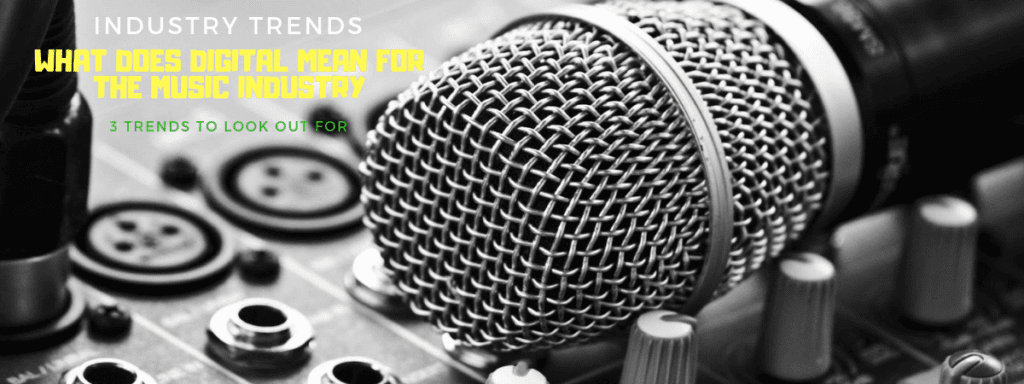
The digital music industry is constantly evolving, with fast-paced technological developments and economic trends contributing to a landscape of perpetual change. Since the turn of the millennium and the digital revolution that followed it, the ways that music is discovered, purchased and consumed have undergone a paradigm shift – and the rate of change hasn’t slowed since. With that in mind, we’re taking a brief look into three recent trends that point towards significant future developments in the digital music industry.
1. Artist/Label-run Streaming Platforms
Since they first began to dominate the digital music industry, there’s been some pushback against the major streaming services, with artists frustrated at insufficient royalty payments and a general lack of control and direction, some feeling overpowered and underappreciated by multi-national corporations that are only concerned with profits and stock prices. This has led some to ask: do artists and musicians need these services? Wouldn’t it be better if the people who made the music could determine every aspect of how it was distributed and consumed?
The movement towards artists and labels running their own distribution platforms and media companies can be traced back to Jay-Z’s historic purchase of Aspiro – the Scandinavian high-definition streaming platform that’s now known as Tidal. Though it’s arguable whether it can be considered a success, Jay’s move into the streaming game was based on good intentions: he and the other artists behind the platform want to shift the power back towards the creators themselves, upping the minimal royalties given out by services like Spotify and Apple Music and changing the status quo.
Justin Vernon and Aaron Dessner of indie acts Bon Iver and The National have attempted something similar with the launch of their “artist-built music platform” PEOPLE. The service is completely free, with the option to contribute a voluntary monthly donation – 80% of which goes to the artists, with 20% being used to maintain the platform itself. It’s a non-commercial venture and all music is uploaded by the artists themselves, with the option to include out-takes, live recordings and unfinished songs to satisfy diehard fans. Though it’s unlikely to ever grow in popularity beyond a novelty for fans of the founders, it’s an innovative idea with noble intentions, demonstrating that artists do have the power to set up their own avenues of distribution without being forced to adhere to existing models.
Artist-owned streaming platforms place power in the hands of the creators, meaning that what’s good for the artists will be what’s good for the platform. Currently, it seems that this isn’t always the case: what’s good for Spotify may not be good for an independent artist struggling to make a living from their craft. Whatever happens next, there’s certainly a case to be made for a shift in the balance of power in the way that music is distributed and consumed today.
2. Streaming Platforms Signing Direct Deals With Artists
Streaming services like Spotify and Apple Music have traditionally followed the conventional model of signing deals with record labels and distributors, who themselves sign deals with artists and musicians. It seems that recently, however, there’s a shift towards a new model, as Spotify license songs directly to artists and their managers, cutting out the middleman and making record labels and distributors redundant.
This benefit both Spotify and the artists: Spotify wins by paying artists a slightly lower royalty rate than it’d pay a record label, but the artists win by keeping 100% of the royalties instead of allowing a label to take a cut. It’s a daring move that risks upsetting the record labels that streaming giants must continue to do business with for years to come. Spotify has made it clear that they don’t intend to compete with labels or replace them in the marketplace, but by offering these deals to lesser-known artists they are effectively cutting record labels and distributors out of the picture.
READ MORE: 10 tips on starting your own record label
In 2016, Apple Music offered Chance The Rapper $500,000 to feature his popular album Coloring Book exclusively on the platform for just two weeks before it was shared for free on SoundCloud. Chance prides himself on his independence from labels and distributors – it’s deals like these that show just how much the industry is changing, shifting power back into the hands of artists and creators and away from institutions that have traditionally controlled the way that music is brought to market.
3. Artists Receiving A Higher Percentage of Industry Revenue
Both of these trends point towards artists eventually receiving a higher share of industry revenue. This is good news – although the figures are still objectively disappointing, with artists only receiving 12% of the $43 billion spent on music last year in the US. Although 12% seems small, it’s actually almost double the 7% figure that artists took home in 2000, and it’s a number that’s set to continue growing.
Artists are building their revenue streams by self-releasing music, making the most of new technologies that allow them to connect directly with consumers and circumvent intermediaries like record labels and distributors. The live touring industry is also doing better than ever – this is another important opportunity for artists who feel they deserve a larger portion of the income their music generates.
READ MORE: Run DMC’s Darryl McDaniels gives his view on the state of contemporary Hip-Hop
The structure of the music industry is changing in response to the developments in technology that the digital age has brought about. It’s now easier than ever for artists and musicians to record, promote, distribute and sell music completely on their own. Only ten or twenty years ago this would have been impossible – artists needed labels and distributors to give them access to studios, to PR, and to distribution networks. Now, thanks to advances in technology and opportunities offered by the internet, artists don’t have to rely on anyone else in order to build their careers and find success. Where this will lead in the future, remains to be seen.

